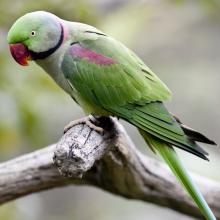Palaeornis eupatria

Conservation Status:
Near Threatened
Range:
South Asia
Habitat:
Forests and cultivated areas
Alexandrine Parakeets are one of the few parrot species where it's easy to tell the difference between males and females. Adult males usually have a black ring around their neck, while the females have a less prominent or no ring at all.
They typically nest in tree cavities, utilizing holes created by other birds or natural hollows in the trunks. These nests are often located at significant heights, providing protection from predators.
In terms of social groups, Alexandrine Parakeets are generally observed in pairs or small flocks. They form strong bonds with their mates and maintain lifelong monogamous relationships. Outside the breeding season, they may gather in larger flocks, sometimes even joining mixed-species groups of parrots.
While Alexandrine Parakeets are native to South Asia, they have been introduced and have established feral populations in certain parts of the world, including Europe, the Middle East, and some Pacific islands.
The establishment of feral populations can have ecological implications as invasive parakeets compete with native bird species for resources such as nesting sites and food.
In addition to the conservation concerns related to their invasive populations, Alexandrine Parakeets are also considered Near Threatened by the IUCN Red List in their native range. Habitat loss, primarily due to deforestation, is one of the major threats they face. The conversion of forests into agricultural land and urbanization has led to the fragmentation and degradation of their natural habitat. Furthermore, illegal trapping for the pet trade continues to be a significant concern, as it affects wild populations and disrupts their reproductive success.
These parakeets are known for their loud and distinct calls and can live up to 30 years.
